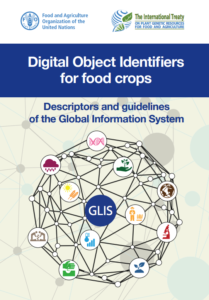 Remember when we told you that you could comment on the draft guidelines for the use of DOIs in plant genetic resources conservation and use? Well, I hope you did, because now they’re out, thanks to the Seed Treaty’s work on developing a Global Information System. Here’s one of the authors, in case you were wondering. And on the same website, that of the Genebank Platform, you can also find out about how his, and the other CGIAR genebanks, are implementing DOIs.
Remember when we told you that you could comment on the draft guidelines for the use of DOIs in plant genetic resources conservation and use? Well, I hope you did, because now they’re out, thanks to the Seed Treaty’s work on developing a Global Information System. Here’s one of the authors, in case you were wondering. And on the same website, that of the Genebank Platform, you can also find out about how his, and the other CGIAR genebanks, are implementing DOIs.
Duty Calls: Forgotten Root Vegetables Edition

It’s a sickness, I know, but when I read the Grauniad article Luigi just nibbled — Salsify: Waitrose brings back ‘forgotten’ Victorian vegetable — I knew I couldn’t rest or, indeed, eat lunch, until I’d set matters straight.
The article says:
The vegetable will be available at Waitrose in the black variety, grown in Cambridgeshire and Norfolk, as well as a small amount of white salsify, which is grown in the sandy soils of Ayrshire in Scotland.
A reasonable person might imagine that there are indeed two varieties of a single crop. An unreasonable one, me, would take to his keyboard in a huff, explaining that the vegetable occasionally known as black salsify, is also known as scorzonera, and is botanically Scorzonera hispanica, while salsify is Tragopogon porrifolius. Admittedly both are in the same family (Asteraceae) but they are not varieties of a single crop, unless that crop is forgotten Victorian root vegetables.
Adding insult to injury, the Guardian’s photograph of Tragopogon porrifolius is captioned “Scorzonera hispanica (salsify) roots with tendrils. Photograph: Dorling Kindersley/Getty Images/Dorling Kindersley”. Right common name, wrong Latin name.
I traced it back to the original. The page itself has vanished, but thanks to the Internet Archive a version has been captured, and though it lacks the image, it does state clearly that it is Tragopogon porrifolius.
Somewhere along the line, probably when Getty Images acquired it from Dorling Kindersley, things got messed up. Certainly Getty’s gallery of salsify images is a jumble of the two species, with Scorzonera predominant.
I’ll go and get my lunch now.
Dutch go wild
Nice little video from CGN on collecting the wild relatives of asparagus and other vegetables.
Brainfood: Climate resilient crops, Food system limits, Phenotyping double, Sweet sorghum, Melon history, Paying4data, Beercalypse, Village chickens, Breeding 4.0, European maize, Brachiaria ROI
- Are agricultural researchers working on the right crops to enable food and nutrition security under future climates? No. Well, kinda.
- Options for keeping the food system within environmental limits. You need to pursue several. Including those discussed above, presumably.
- Deep Learning for Plant Stress Phenotyping: Trends and Future Perspectives. 3D CNN architectures applied to hyperspectral imaging is the future, apparently.
- Dealing with multi‐source and multi‐scale information in plant phenomics: the ontology‐driven Phenotyping Hybrid Information System. You’re going to need a fancy system to keep track to the data from the above.
- Sweet Sorghum Originated through Selection of Dry, a Plant-specific NAC Transcription Factor Gene. Could be applied to other cereals?
- Repeated domestication of melon (Cucumis melo) in Africa and Asia and a new close relative from India. Once was not enough.
- Paying for Digital Information: Assessing Farmers Willingness to Pay for a Digital Agriculture and Nutrition Service in Ghana. Cheaper is better. There’s a shocker. Oh, and women are more careful with their money.
- Decreases in global beer supply due to extreme drought and heat. 32% decrease in consumption in Argentina, 193% increase in price in Ireland. But clearly the authors have never heard of sorghum beer.
- The role of local adaptation in sustainable production of village chickens. Location, location, location.
- On the Road to Breeding 4.0: Unraveling the Good, the Bad, and the Boring of Crop Quantitative Genomics. Beyond breeding on predicted phenotypes, it’s sort of breeding for predicted environments.
- Maize yields over Europe may increase in spite of climate change, with an appropriate use of the genetic variability of flowering time. You don’t even need Breeding 1.0, if you deploy existing diversity optimally.
- Got forages? Understanding potential returns on investment in Brachiaria spp. for dairy producers in Eastern Africa. Definitely worth a flutter.
Brainfood: Emmer & drought, European legumes, Sainfoin, Alpine nomads, American domestication, Cereal domestication, Tree plantations, Garlic breeding, African veggies, African staple breeding, Sugarcane genome
- Genetic contribution of emmer wheat (Triticum dicoccon Schrank) to heat tolerance of bread wheat. It’s considerable.
- Warm Season Grain Legume Landraces from the South of Europe for Germplasm Conservation and Genetic Improvement. Ok ex situ, in situ not so much.
- Onobrychis viciifolia; a comprehensive literature review of its history, etymology, taxonomy, genetics, agronomy and botany. The fall and rise of an orphan forage.
- Interstitial but Resilient: Nomadic Shepherds in Piedmont (Northwest Italy) Amidst Spatial and Social Marginalization. Truly a vale of tears.
- Parallel vs. Convergent Evolution in Domestication and Diversification of Crops in the Americas. Still can’t tell which is more prevalent.
- Whole-Genome Analysis of Candidate genes Associated with Seed Size and Weight in Sorghum bicolor Reveals Signatures of Artificial Selection and Insights into Parallel Domestication in Cereal Crops. 63 seed size genes selected during domestication in sorghum, a significant number of which in maize and rice also.
- A systematic review of the socio-economic impacts of large-scale tree plantations, worldwide. Not a good idea.
- Recent Advances in Sexual Propagation and Breeding of Garlic. Restoration of flowering ability has done wonders for diversity. With diversity poster goodness.
- Core collection of two important indigenous vegetables; Gboma eggplant (Solanum macrocarpon L.) and Jute mallow (Corchorus olitorius L.) in Africa: An important step for exploitation of existing germplasm and development of improved cultivars. Interesting, of course, but I wouldn’t call these core collections. But I won’t complain again if it gets the stuff used more.
- Measuring the impact of plant breeding on sub-Saharan African staple crops. High ROI for the usual suspects. How about the traditional veggies et al., though. Anyway, do readers want more on this paper? Let me know in the comments if you want a full post on the main findings.
- Allele-defined genome of the autopolyploid sugarcane Saccharum spontaneum L. A lot of the good stuff is in wild-cultivated rearranged chromosomes.